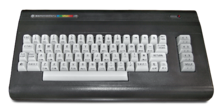This article needs additional citations for verification. (March 2019) |
 Commodore 16 | |
| Manufacturer | Commodore Business Machines |
|---|---|
| Product family | Commodore 264 series |
| Type | Home computer |
| Release date | 1984 |
| Introductory price | US$99 (equivalent to $290 in 2023) |
| Discontinued | 1985 |
| Units shipped | 1,266,000 (worldwide) |
| Media | ROM cartridge, Compact Cassette |
| Operating system | Commodore KERNAL/BASIC 3.5 |
| CPU | MOS Technology 7501 or 8501 @ 0.89/1.76 MHz (avg. approx. 1.1 MHz)[1] |
| Memory | 16 KB RAM + 32 KB ROM[2] |
| Display | 320×200, 320×160 (with 5 lines of text), 160×200, 160×160 (with 5 lines of text) |
| Graphics | TED (320 × 200, 121 colors)[2][3] |
| Sound | TED (2 channels, 4 octaves + white noise)[2] |
| Input | Keyboard (66 keys, 4 function keys, 4 cursor keys), joystick |
| Dimensions | 40.7 cm × 20.4 cm × 7.7 cm (16.0 in × 8.0 in × 3.0 in)[2] |
| Related | Commodore Plus/4 |
 | |
| Type | Home computer |
|---|---|
| Input | Keyboard |

The Commodore 16 is a home computer made by Commodore International with a 6502-compatible 7501 or 8501 CPU, released in 1984 and intended to be an entry-level computer to replace the VIC-20. A cost-reduced version, the Commodore 116, was mostly sold in Europe.
The C16 and C116 belong to the same family as the higher-end Plus/4 and are internally very similar[4]: 24 to it (albeit with less RAM – 16 KB rather than 64 KB – and lacking the Plus/4's user port[2] and Three-Plus-One software). Software is generally compatible among all three provided it can fit within the C16's smaller RAM and does not utilize the user port on the Plus/4.
While the C16 was a failure on the US market, it enjoyed some success in certain European countries and Mexico.
- ^ Cite error: The named reference
c64_wikiwas invoked but never defined (see the help page). - ^ a b c d e Cite error: The named reference
old_computers_c16was invoked but never defined (see the help page). - ^ Cite error: The named reference
boray.sewas invoked but never defined (see the help page). - ^ Cite error: The named reference
Plus4Manualwas invoked but never defined (see the help page).